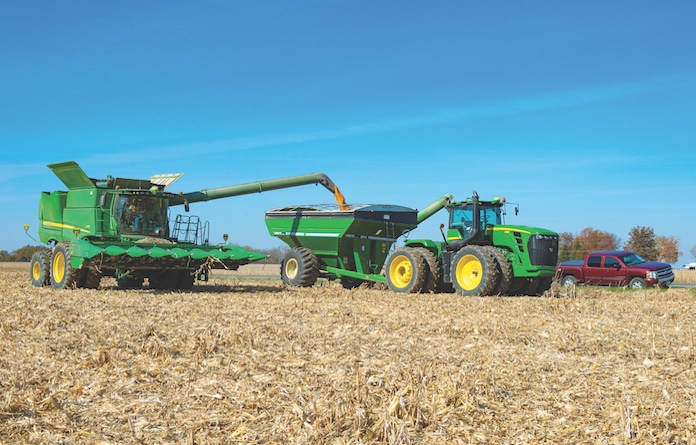Hard work for a hurried harvest

If 2019 illustrates any guarantees and certainties about farming, it is that there are precious few of them.
Trade disputes have weighed on income results, and weather has as well. Many of the issues facing area farmers have centered around impacts of timing as they plant, treating emerging crops and then harvesting them.
The Republic-Times sat down with Gateway FS Grain Division Manager Adam Parker in Red Bud on Monday morning as mists started to wet the ground and bring harvesting to a halt.
Concerning rainfall across Monroe County, he said it has actually been pretty good. Areas to the east got a lot more rain the first two months of the summer, he said, and then little to none at the end.
Perhaps Parker best summarized what farmers are experiencing countywide when he said “planted acres have provided good crops.”
But, he continued, many acres in the bottoms – which is an area of rich soils that can host bumper crops – were never planted because of flooding and excessive wetness.
“The Mississippi River has been high since March, and it still is,” he said.
The big three crops in Monroe County are wheat, corn and beans.
The wheat harvest was quite good, Parker reported. Wheat grown in this area is commonly called winter wheat. It is planted in the fall and the smooth green wheat fields emerging in the area now are ready for winter and will not be hampered by snow or cold.
They will hunker down and be ready to take off in the spring.
Wheat is always a worrisome crop, Parker reported. In addition to weather issues, it is subject to fungus and other diseases as it grows, which hopefully may be adequately countered by timely spraying with the proper chemicals.
“Farmers never feel over-confident about wheat until it is harvested and in the bin,” he said.
The local yield this year generally ranged from 60-70 bushels per acre. This is an average figure over recent years.
Corn is planted in the spring. This year saw heavy rain early in the season, which made fields muddy and difficult to get into with heavy machinery to plant the crop. Some area farmers took risks as they planted corn right up to the end of June – a typical deadline for starting this crop.
But the acres planted have delivered very good yields, Parker said, from 160 bushels per acre and up.
“Some have reported 200 bushels an acre, which is very good,” he added.
But again, corn that could not be planted in the bottoms has been a loss.
Beans are planted in the spring at the same time as corn. But a second bean planting – termed a double crop – is planted in the early summer in fields from which wheat has been harvested.
This second crop of beans is what can be seen, dry and brown, in fields today. They can be harvested even after a freeze – as long as the soil is dry enough to operate machinery on.
“We saw bean yields in the 50-60 bushels per acre range,” Parker assessed. “That’s good to above average.”
Much of the flooding and under-levee seepage that kept planting halted in the bottoms can be attributed to a river few are aware of in Monroe County: the Missouri River.
The basin it drains across the Northern Plains received heavy snow last year, which resulted in over average spring run-off. Then, reservoirs that normally would manage the flow from that river had to be opened to accommodate repeated rainfalls of as much as six inches at a time.
Although this has also impacted river navigation for a time on the Mississippi River in the St. Louis area and southward, for the most part barge traffic has continued to safely move farm commodities to overseas shipping points in Louisiana.
A visible impact of the weather here was seen this past weekend. While many people in Monroe County relished the warm, sunny weather with outdoor activities, farmers were working hard – almost desperately – to finish harvests before the bottom dropped out on them, especially their fields of corn.
Those frequenting rural roads saw seemingly endless flows of large trucks hauling harvested corn, either to individual bins or to market. As much as 10-15 percent of this year’s corn crop is in danger if there’s a substantial wet snow.
In fact, Parker reported, “while this time in November is normally very slow for us, the FS elevator in Waterloo saw the greatest volume of business this past weekend in the entire 2019 harvest year.”
Overall, the American Farm Bureau Federation, reports farm incomes are expected to reach $88 billion in 2019, with $33 billion of that from crop insurance that farmers pay for to balance risks, government disaster assistance and the annual farm bill. While bankruptcies are up from last year, and at 10-year highs, they are still below the record highs seen in the 1980s.
As fields are yielding their final crops across North America, similar crops are being planted in South America for 2020 harvests while farmers here are, in turn, planting. And the rest of the world, including the huge population of China, has billions of people to feed.
Farmers would generally rather depend on free trade than government subsidies, Parker summarized.
But while politics and media assessments of international trade dominate the news, the blend of uncertainty and dogged determination that characterizes farming and those engaged in it, continues.
And it will in 2020 and the years to follow.
In fact, determination and readiness to work hard – very hard – are the only for-sure things about farming.






